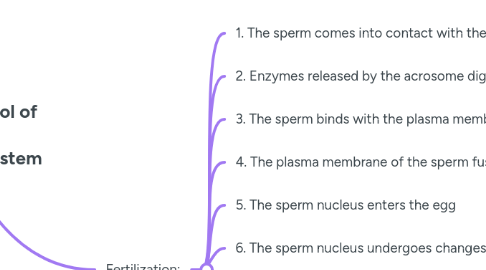
1. Pregnancy and Child Birth
1.1. Oxytocin
1.1.1. Causes uterine contractions for child brith
1.2. Prostaglandins
1.2.1. Produced in response to oxytocin strengthens uterine contractions
1.3. Relaxin
1.3.1. Relaxes the pelvic ligaments and cervix for child birth
2. Menstrual Cycle
2.1. Ovarian Cycle: cyclic changes seen in the ovaries and can be further subdivided into three phases
2.1.1. Follicular Phase: This phase begins in day 1 of the menstrual flow and last 14 days.
2.1.1.1. The anterior pituitary secretes follicle-stimulating hormone (FSH) and luteinising hormone (LH). Inside each ovary are small sac-like fluid-filled structures or the follicles , with each follicle containing one immature egg. FSH stimulates the growth of these ovarian follicles. The growing follicle secretes oestradiol (the primary form of oestrogen in a human female).
2.1.2. Ovulation Phase: Phase occurs in day 14 of the 28 day cycle. The release of an egg from the ovary in animals.
2.1.2.1. sharp rise in the level of oestradiol stimulates the anterior pituitary to secrete LH (to a greater extent) and FSH (to a lesser extent). The spurt of LH causes the follicle to rupture, releasing the mature egg.
2.1.3. Lutheal Phase: Under the influence of LH, the ruptured follicle is converted into the corpus luteum (yellow body) wherein the ruptured follicle is filled with cells.
2.1.3.1. Following ovulation, LH and FSH levels drop. The corpus luteum secretes progesterone and oestradiol. As the levels of oestradiol and progesterone rise, the secretion of FSH and LH is inhibited by a negative feedback mechanism. This stage lasts for about 14 days.
2.2. Uterine Cycle: changes that occur in the uterus
2.2.1. Proliferative Phase: The proliferative phase coincides with the follicular phase and continues till ovulation. Oestradiol secreted by the growing follicle causes a thickening of the endometrial lining of the uterus preparing it for a possible pregnancy.
2.2.2. Secretory Phase: The secretory phase roughly corresponds to the luteal phase of the ovarian cycle. Under the influence of progesterone, the uterine lining thickens further and changes into a secretory layer, in preparation for a potential implantation.
2.2.3. Menstruation Phase:
3. Fertilization:
3.1. 1. The sperm comes into contact with the egg
3.2. 2. Enzymes released by the acrosome digest the zona pellucida
3.3. 3. The sperm binds with the plasma membrane of the oocyte
3.4. 4. The plasma membrane of the sperm fuses with the plasma membrane of the egg
3.5. 5. The sperm nucleus enters the egg
3.6. 6. The sperm nucleus undergoes changes to form the male pronucleus
3.7. 7. The male pronucleus binds to the female pronucleus to form the diploid nucleus
3.7.1. After fertilization, the fertilized egg (called a zygote) begins to rapidly divide and travel down the fallopian tube towards the uterus, where it eventually implants itself in the uterine lining, a process called implantation, and starts developing into an embryo, marking the beginning of pregnancy
3.7.1.1. 1. Zygote formation: When a sperm cell meets an egg, they fuse together to form a single cell called a zygote.
3.7.1.2. 2. Cleavage: The zygote repeatedly divides mitotically, creating a ball of cells called a blastocyst.
3.7.1.3. 3. Blastocyst development: The blastocyst travels down the fallopian tube and reaches the uterus.
3.7.1.4. 4. mplantation: The blastocyst attaches itself to the uterine lining.
3.7.1.5. 5. Embryo development: Once implanted, the inner cells of the blastocyst begin to differentiate into the different tissues and organs of the embryo.
3.7.1.6. 6.Hormone production: After implantation, the developing embryo releases hormones like human chorionic gonadotropin (hCG) which can be detected in a pregnancy test.
